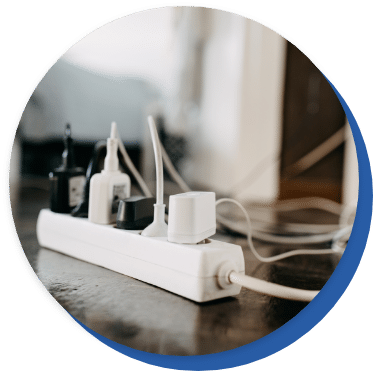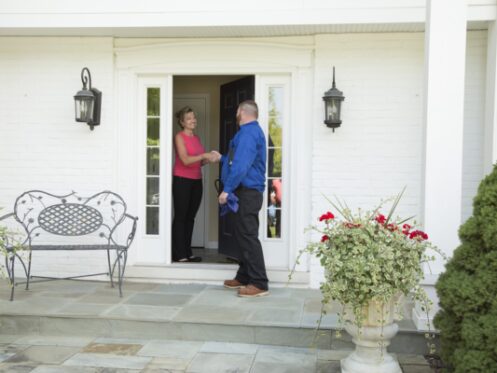House fires can be absolutely devastating, leaving families feeling helpless. There are serious consequences of house fires. Having a working smoke alarm reduces one’s chances of dying in a fire by nearly half. Even assuming that loss of life and personal injury is avoided, the destruction of property and personal effects can have a vast and lifelong impact on people’s lives. The good news is that most house fires are preventable. All house fires can be preventable with just a few safety measures and sensible protocols. As many as 400,000 house fires occur every year across the US, and most of these can be avoidable. The statistics on house fires speak themselves, but what can be done to prevent them?
The Dangers of House Fires
Seventy-five percent of all fire deaths were caused by home fires. This includes the 64 percent that resulted from fires in one- or two-family homes and the 11 percent caused by fires in apartments or other multi-family housing. House fires can be very terrifying and cause a lot of stress for those affected. Almost all home fires are caused by accidents or issues that can be prevented. Awareness of the most common causes of fires and taking a few simple, precautionary steps can save you and your family from the devastating consequences of a fire in your home.
Top Five Causes of Accidental House Fires
According to official data from the National Fire Protection Association (NAPA), most home fires and fire casualties result from five causes: cooking, heating, electrical distribution and lighting equipment, intentional fire setting, and smoking materials. More than one-quarter (26%) of reported fires in 2015-2019 occurred in homes. Even worse, three-quarters (75%) of civilian fire deaths and almost three-quarters (72%) of all reported injuries were caused by home fires.
Cooking
Home fires are more likely to start in the kitchen than any other room in your home. Over the five-year period of 2015–2019 as a whole, cooking was the leading cause of home fires and home fire injuries, while smoking was the leading cause of home fire deaths. It is stated that unattended cooking causes nearly 90 percent of all kitchen fires.
Here are Some Tips to Prevent Cooking Fires
- Never leave cooking food unattended.
- Stay in the kitchen when you are frying, grilling, or broiling food. If you do leave the kitchen for even a short period of time, turn off the stove.
- Avoid wearing loose clothing or dangling sleeves while cooking.
- Keep kids away from cooking areas.
- Keep anything that can catch on fire—pot holders, oven mitts, wooden utensils, paper or plastic bags, food packaging, and towels or curtains—away from your stovetop and oven or any other appliance in the kitchen that generates heat.
- Clean cooking surfaces on a regular basis to prevent grease buildup.
The number of home fires the American Red Cross has responded to has risen 10% since 2000. By remembering and using these tips, you can prevent dangerous home fires.
Heating Equipment
It is stated that home heating equipment is the leading cause of U.S. home fires during the months of December, January, and February, when nearly half (48 percent) of all U.S. home heating equipment fires occur. Failure to clean equipment was the leading cause of home heating fires, with creosote build-up in chimneys presenting a particular issue. Space heaters are the type of equipment most often responsible for home heating equipment fires, accounting for more than two in five fires. Fireplaces and chimneys caused 30 percent of heating equipment fires. Be sure to take care of any heating repair needs with your furnace or other heating systems to ensure everything is working properly and safely.
Heating Equipment Safety Tips and Tricks
- Heating equipment and chimneys should be cleaned and inspected yearly by a qualified professional.
- Keep anything that can burn at least three feet away from all heating equipment (furnaces, fireplaces, wood stoves, and space heaters).
- Never leave space heaters on in unattended rooms.
- If you smell gas in your gas heater, do not light the appliance.
Appliances and Electrical Systems
Residential building electrical fires occurred most often in the winter month of January (12%) due to increased use of heating appliances and lights. Most electrical fires are caused by faulty electrical outlets. As outlets and switches get older, the wiring wears and essentially tears. systems with frayed and damaged cords are a massive fire hazard. Old and outdated electrical wiring can also cause house fires. This is because the old wires cannot handle the new power load. Overuse of extension cords can also cause house fires. When you have multiple things plugged into an extension cord at once, It creates an excessive power load that overloads the whole system, causing it to overheat, and even catch fire. A whole-home surge protector is a great idea to consider!

Light fixtures, lamps, and light bulbs are other common reasons for electrical fires. It is important to always check the maximum bulb wattage on light bulbs and lamps to ensure you do not exceed it. Lastly, space heaters are very flammable and should never be left unattended. Electrical repair performed by a professional electrician as needed can prevent many of these issues.
Tips For Preventing Electrical Fires
- Repair or replace loose outlets as soon as you notice them.
- Call a qualified electrician to inspect the home electric system and replace old wiring.
- Ensure that all light bulbs and lighting devices are plugged into electrical sockets that match the prescribed wattage.
- Avoid overuse of extension cords and the use of extension cords for lamps.
- Never leave a portable space heater unattended.
Lighting
Light fixtures, lamps, and light bulbs can all be culprits of house fires. It is important to always remember to unplug any unnecessary lighting when you leave the house, this will not only save electricity but also reduce the chances of the light bulb overheating. Lastly, it is important to follow all holiday decoration safety instructions, regarding lights. If you need assistance with your lighting, consulting with a trusted local electrician is best practice.
Smoking
Smoking was the leading cause of home fire deaths for the five-year period of 2012-2016. Overall, one of every 31 home smoking material fires resulted in death. Cigarette and smoking related fires are among the top causes of fire related fatalities. Smoking in your home puts everyone at risk – not only from secondhand smoke but also by increasing the risk of a smoking related fire.
Additional Ways That House Fires Are Sometimes Started
According to a report from the NFPA, there are a range of additional ways that house fires are started every year.
- Candles
- Fans and air conditioning equipment
- Christmas trees
- Office equipment
Improving Fire Safety in Your Home
It is extremly important to follow fire saety guidelines in order to prevent disasters. One of the best maintence you can do is update your smoke detectors by changing the batteries regularly. Make sure to always have a fire extinguishers on hand. Lastly, if you have children it is important not to leave matches or lighters unattened and to educate your kids about fire safety.

